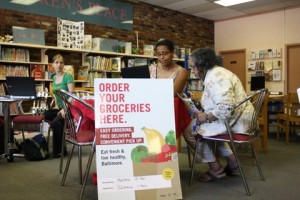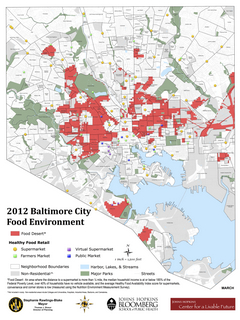
A woman orders food from Baltimarket’s virtual supermarket at the Cherry Hill Library location in Baltimore. (Photo courtesy of Baltimore City Health Department)
ANNAPOLIS—Food deserts are a significant issue in Maryland — but just how severe they are depends on whom you ask. Although the term has been in common use for years, there is no all-encompassing definition of what constitutes a food desert. Baltimore provides a perfect example of the disagreement.
The United States Department of Agriculture estimates about 15 percent of Baltimore City residents are living in food deserts, while the city’s Baltimore Food Policy Initiative says it’s more like 20 percent based on a study conducted by Baltimore City Department of Planning and Johns Hopkins Center for a Livable Future. And a national hunger-relief organization, Feeding America, estimates 22 percent of people living Baltimore City are “food insecure.”
The reasons for these discrepancies stems from each organization’s definition of the term “food desert.” “In general, you’ll see that every definition looks at what food is available, and income level,” said Laura Flamm, food access coordinator for Baltimarket, an online grocery ordering service for Baltimore residents with low access to food.
“But there is really nothing set in stone.”
The USDA’s definition of a food desert says that for it to be included, a census tract must be defined as both low-income and low-access. For a census tract to qualify as low-income, either the poverty rate must be at least 20 percent or the median family income of that tract must be at or below 80 percent of the area’s median family income.
To qualify as low-access, either 500 or more people, or one-third of a census tract’s population, must live at least one mile from a supermarket or grocery store.

A detailed map of food deserts in Baltimore City created in 2012 by the Baltimore City Department of Planning, and the Johns Hopkins Center for a Livable Future. (Map courtesy of Baltimore City Department of Planning and Johns Hopkins Center for a Livable Future.)
Using these parameters, about 15 percent of Baltimore City residents reside in a food desert. However, using a one-mile radius to identify food deserts may ignore unique hurdles associated with travel in an urban setting.
In their food desert report to Congress, the USDA recognized these concerns:
“Obviously, whether walking to a supermarket is feasible or not depends on more than just distance — it could also depend on whether the individual is capable of walking that distance, whether there are safe sidewalks on which to walk, and controlled intersections, and whether there are other barriers, such as crime, that may make walking to a store dangerous.”
Another limitation of the one-mile measurement is that it’s calculated using a straight line, which will not represent the real distance when zig-zagging through city blocks or if a major obstacle, such as a river or highway, stands in the way.
Still, the report concludes that, “despite these limitations, (using one mile as a) definition of walkability is grounded in the literature.” The USDA then cites three other reports, which all conclude that distances of more than a half mile are walkable in urban settings. But according to the Johns Hopkins Center for a Livable Future, one mile is too far.
When they created their “Baltimore City Food Environment Map” in 2012, they defined a food desert using one-quarter of a mile as a reasonable distance to a grocery store or market.
“The USDA was constrained for coming up with a number that worked on a national level — but we know that if you drill down further you can get more accurate,” said Amanda Behrens Buczynski, a senior program officer for John Hopkins Center for a Livable Future. “The boundaries of Baltimore City aren’t that large and when we considered distance to the supermarket, we had to consider that you’d be carrying groceries, too.”
Behrens Buczynski was a project manager for the mapping project. While this alternative map was based on the same census data as USDA’s, it also considered vehicle access and income as factors to determine food deserts. In their definition of a food desert, the median household income is at or below 185 percent of the federal poverty level, and 40 percent of households do not own a vehicle.
Using these measurements, about one in five, or 20 percent, of Baltimore City residents live in a food desert. Although Johns Hopkins and the USDA may disagree on how to define food deserts in Baltimore City, they agree that something can, and maybe should, be done to eradicate them.
Urban farming, community gardens, public markets and farmers markets in Baltimore City offer some healthy food options for food desert areas, but they are not enough to alleviate the problem entirely.
Baltimarket, a virtual supermarket program run by the Baltimore City Health Department, may provide another means for addressing low access to food in some neighborhoods. Baltimarket partners with Shoprite grocery store to deliver food to those living in food deserts in Baltimore City.
“We are the first program in the country to address food access in partnership with a major retailer,” said Flamm. The program is 5 years old, and manages four locations in Baltimore City where locals can come to order groceries online and then pick them up a day or two later from the same location. Food stamps are accepted through the program and deliveries are made at no additional cost thanks to funding by the United Way of Central Maryland and Kaiser Permanente, Flamm said.
This December, Baltimarket will expand their program to two new sites in the city.

